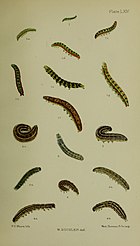Aporophyla australis
Forewing whitish grey with a slight lilac tinge; the veins darker, the costa, inner margin narrowly, a median shade between the stigmata, some wedge-shaped subterminal blotches in the interspaces before subterminal line, and the dark chequering of the fringe brown; inner and outer lines both strongly dentate, but rarely plain, except as streaks on inner margin; stigmata finely outlined with black, the orbicular narrow, oblique, the reniform broader, both, when clear, with a dark centre; the streak from base on submedian fold brown and indistinct; a brown shade often visible on submedian fold between claviform stigma and outer line; hindwing in male white, in female slightly flushed with brown; for this type form Guenée gives Provence and Corsica as localities; - ab.
nov. [Warren] is a larger form, with the brown tints of the type replaced by blackish fuscous, the costal area of forewing and the fringe especially darkened; the lines equally indistinct; of this I have seen a pair from Rome, a female marked simply Germany, and a single male from Amasia : - scriptura Frr.
is uniform dark grey, with the inner and outer lines distinct and dentate; —of this ingenua Frr.
— cinerea Stgr., from Morocco, is also described as having the forewings unicolorous grey; — pascuea is the British form, which is nearest the type, but whiter, with all the markings very strongly developed and black in the male, the female pinkish grey; the orbicular stigma varies much in this form from a small round to a long elliptical mark becoming confluent with the reniform.
[2] The larva is yellowish green tinged with reddish above; a pale reddish line along the middle of the back has black V-shaped marks upon it, and there is a series of black marks on each side; the line along the spiracles is yellowish.
